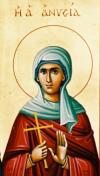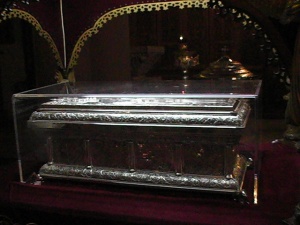Difference between revisions of "Anysia of Thessaloniki"
m |
m |
||
| Line 11: | Line 11: | ||
==Hymns== | ==Hymns== | ||
| − | [[Kontakion]] in the Third Tone <ref> Copyright to Holy Transfiguration Monastery</ref> | + | [[Kontakion]] in the Third Tone <ref> Copyright of the Kontakion to Holy Transfiguration Monastery</ref> |
:As a doubly-shining lamp of truly mystical brightness | :As a doubly-shining lamp of truly mystical brightness | ||
:do ye shine upon the Church like a high-towering beacon: | :do ye shine upon the Church like a high-towering beacon: | ||
Revision as of 02:30, December 23, 2008
Life
Anysia was born and lived in Thessaloniki during the Diocletian-Maximian persectutions (284-305). She was the daughter of both rich, but very pious parents. After her parents' death, Anysia lived a very quiet and God pleasing life fulfilling his commandements. She was not overwhelmed by the wealth she inherited rather she took private vows of poverty and chastity and used her wealth to help the poor. Her fear of God became widespread even amongst the idolaters. One day as she was heading off to church she met a Roman pagan soldier. This soldier arrested her against her will and dragged her to a temple to worship to the sun god. Anysia refused and confessed her faith in the one and true God, Jesus Christ. The soldier was so enraged by her response that he abused her even more and started to blaspheme the name of God. Anysia unable to hear his blasphemy spat in his face and covered her face with a veil. Embaressed and angered by her actions, the soldier ripped the veil away from her face to peer at her and drove a sword into her side immediately killing her.[1]
Relics
The relics of St. Anysia are contained on the left-hand side in the Church of St. Demetrios in Thessaloniki.
Hymns
Kontakion in the Third Tone [2]
- As a doubly-shining lamp of truly mystical brightness
- do ye shine upon the Church like a high-towering beacon:
- thou with beams of martyr's glory, O Anysia;
- thou with rays of great ascetic deeds, O Melania.
- Now together ye are honoured by Christ your Bridegroom for your travails in His Name.
Notes
- ↑ There are two authentic bibliographies on the Saint. The first is by an anonymous author (page 107-111) and the second is by the archdeacon Gregorios (page 113-119) in:
- Viteau, J., Passions des saints Écaterine et Pierre d’Alexandrie, Barbara et Anysia, Paris 1897.
- ↑ Copyright of the Kontakion to Holy Transfiguration Monastery
Categories > Church History
Categories > Church History
Categories > Church History
Categories > Church History
Categories > Church History
Categories > Liturgics > Feasts
Categories > Liturgics > Feasts
Categories > Liturgics > Feasts
Categories > Liturgics > Feasts
Categories > Liturgics > Feasts
Categories > People > Saints
Categories > People > Saints > Ante-Nicene Saints
Categories > People > Saints > Byzantine Saints
Categories > People > Saints > Greek Saints
Categories > People > Saints > Saints by century > 4th-century saints

